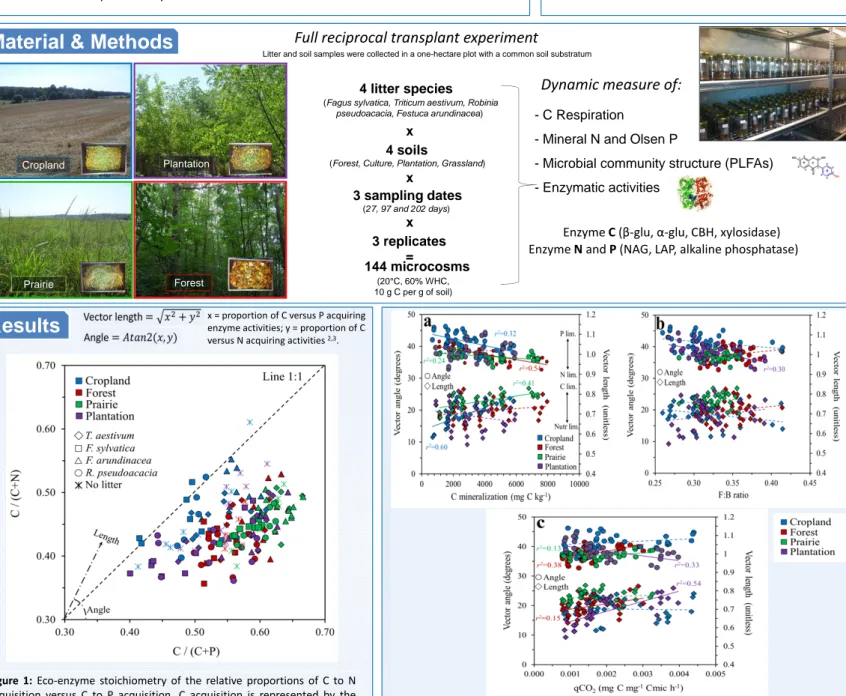HAL Id: hal-02740564
https://hal.inrae.fr/hal-02740564
Submitted on 2 Jun 2020
HAL is a multi-disciplinary open access
archive for the deposit and dissemination of
sci-entific research documents, whether they are
pub-lished or not. The documents may come from
teaching and research institutions in France or
abroad, or from public or private research centers.
L’archive ouverte pluridisciplinaire HAL, est
destinée au dépôt et à la diffusion de documents
scientifiques de niveau recherche, publiés ou non,
émanant des établissements d’enseignement et de
recherche français ou étrangers, des laboratoires
publics ou privés.
Eco-enzymatic stoichiometry and enzymatic vectors in
decaying litter reveal differential C, N, P dynamics
along a land-use gradient
Nicolas Fanin, D Moorhead, Isabelle Bertrand
To cite this version:
Nicolas Fanin, D Moorhead, Isabelle Bertrand. Eco-enzymatic stoichiometry and enzymatic vectors
in decaying litter reveal differential C, N, P dynamics along a land-use gradient. 5. International
EcoSummit: Ecological Sustainability: Engineering Change, Aug 2016, Montpellier, France. 2016.
�hal-02740564�
Introduction
Results
Objectives
Material & Methods
At a global scale, eco‐enzymatic ratios were shown to provide a functional measure of the threshold at which control of community metabolism shifts from nutrient to carbon limitation1. However at a finer scale, the controls of nutrient availability on microbial community structure and associated enzyme production are still poorly understood. Microbial decomposer communities cope with substrates that vary considerably in C:N:P stoichiometry compared to that of their own biomass. Changes in relative abundances of extracellular enzymatic activities (EEA) involved in C, N, and P cycling should reflect relative resource acquisition by these communities.
Evaluate the eco‐enzymatic theory using a land‐ use gradient under controlled conditions.
Litter and soil samples were collected in a one-hectare plot with a common soil substratum
Cropland Plantation Forest Prairie 4 litter species x 4 soils 3 sampling dates 3 replicates = x
(Fagus sylvatica, Triticum aestivum, Robinia
pseudoacacia, Festuca arundinacea)
(Forest, Culture, Plantation, Grassland)
(27, 97 and 202 days) x 144 microcosms (20°C, 60% WHC, 10 g C per g of soil)
Conclusions
Figure 1: Eco‐enzyme stoichiometry of the relative proportions of C to N acquisition versus C to P acquisition. C acquisition is represented by the sum of β‐1,4‐glucosidase (BG), β‐D‐cellobiosidase (CBH), β‐xylosidase (XYL), and α‐1,4‐glucosidase (AG); N acquisition is represented by the sum of β‐ 1,4‐N‐acetylglucosaminidase (NAG) and leucine aminopeptidase (LAP); and P acquisition is represented by alkaline phosphatase (AP) activity
References
Enzyme C (β‐glu, α‐glu, CBH, xylosidase) Enzyme N and P (NAG, LAP, alkaline phosphatase)
1Sinsabaugh R.L., Hill B.H., Follstad J.J. (2009) Eco-enzymatic stoichiometry of microbial organic nutrient acquisition in soil and sediment. Nature 462: 795-798.
Eco-enzymatic stoichiometry and enzymatic
vectors in decaying litter reveal differential C,N,P
dynamic along a land-use gradient
Nicolas FANIN
a,b,
Daryl MOORHEAD
c,
Isabelle BERTRAND
daINRA UMR FARE, F‐51100 Reims; bSwedish University of Agricultural Sciences, Umea; cUniversity of Toledo, USA; dINRA UMR Eco&Sols, F‐34000 Montpellier
Isabelle.bertrand@supagro.inra.fr
EPRC program
Use length and angle of enzyme vectors2 to explore relationships between EEA and mineralization rates, microbial metabolism and community structure.
Full reciprocal transplant experiment
- C Respiration
- Mineral N and Olsen P
- Microbial community structure (PLFAs) - Enzymatic activities
Dynamic measure of:
x = proportion of C versus P acquiring enzyme activities; y = proportion of C versus N acquiring activities 2,3.
Figure 2: Relationships between vector lengths and angles with a) carbon mineralized, b) Fungi:Bacteria ratio, and c) metabolic quotient according to vector angle (circle) or length (diamond) (litter types combined). Full lines represent significant relationships and associated r2values. ‐ EEA showed that N requirements increased relative to P during litter decay but C requirements increased more rapidly than either N or P in most of these ecosystems. ‐ Shifts in EEA were related to changes in metabolic quotient (C respired per unit biomass) but not in fungi:bacteria ratios. Functional abilities of soil microbes may be more important than their identity for assessing their resource requirements. ‐ The use of EEA as a proxy of microbial resource demand improved our understanding of temporal shifts in resource requirements to microbial communities.
2Moorhead DL, Sinsabaugh RL, Hill BH, Weintraub MN (2016) Vector analysis of ecoenzyme activities reveal constraints on coupled C, N and P dynamics. Soil
Biology & Biochemistry 93: 1-7
Fanin N, Moorhead DL, Bertrand I (2016) Eco‐enzymatic stoichiometry and enzymatic vectors reveal differential C,N,P dynamics in decaying litter along a land‐use gradient. Biogeochemistry, 129: 21‐36
